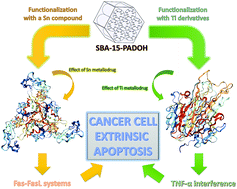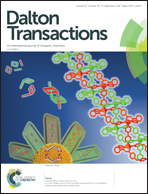Modulation of the mechanism of apoptosis in cancer cell lines by treatment with silica-based nanostructured materials functionalized with different metallodrugs†
Abstract
The mesoporous silica-based material SBA-15 (Santa Barbara Amorphous-15) has been modified with the aminodiol ligand 3-[bis(2-hydroxyethyl)amino]propyltriethoxysilane (PADOH) to give the corresponding material SBA-PADOH. Subsequent functionalization with a diorganotin(IV) compound, SnPh2Cl2 (1), and with two titanocene derivatives, TiCp2Cl2 ([Ti(η5-C5H5)2Cl2] (2)) and TiCpCpPhNfCl2 ([Ti(η5-C5H5)(η5-C5H4CHPhNf)Cl2] (3) (Ph = C6H5; Nf = C10H7)), gave the materials SBA-PADO-SnPh2 (M1), SBA-PADO-TiCp2 (M2) and SBA-PADO-TiCpCp* (M3), respectively. SBA-PADOH and M1–M3 have been characterized by various techniques such as FT-IR, XRD, XRF, solid-state NMR, nitrogen adsorption–desorption isotherms, electrochemical methods, SEM and TEM, observing that the functionalization has mainly taken place inside the pores of the corresponding porous system. In addition, mechanistic aspects of the apoptosis triggered by the synthesized materials have been studied in vitro in tumour cell lines derived from three distinct types of cancer in order to elucidate their growth inhibition and interference with the expression of tumour necrosis factor alfa (TNF-α) and the first apoptosis signal receptor (Fas or tumour necrosis factor receptor 6). It was observed that the antiproliferative and proapoptotic capacity of the materials depends on their functionalization with the different cytotoxic prodrugs (organotin or titanocene derivatives). The study shows that M1–M3 influence the metabolic activity of the tumour cells and modulate the apoptotic pathways by different mechanisms, according to the active compound inside the material.



 Please wait while we load your content...
Please wait while we load your content...